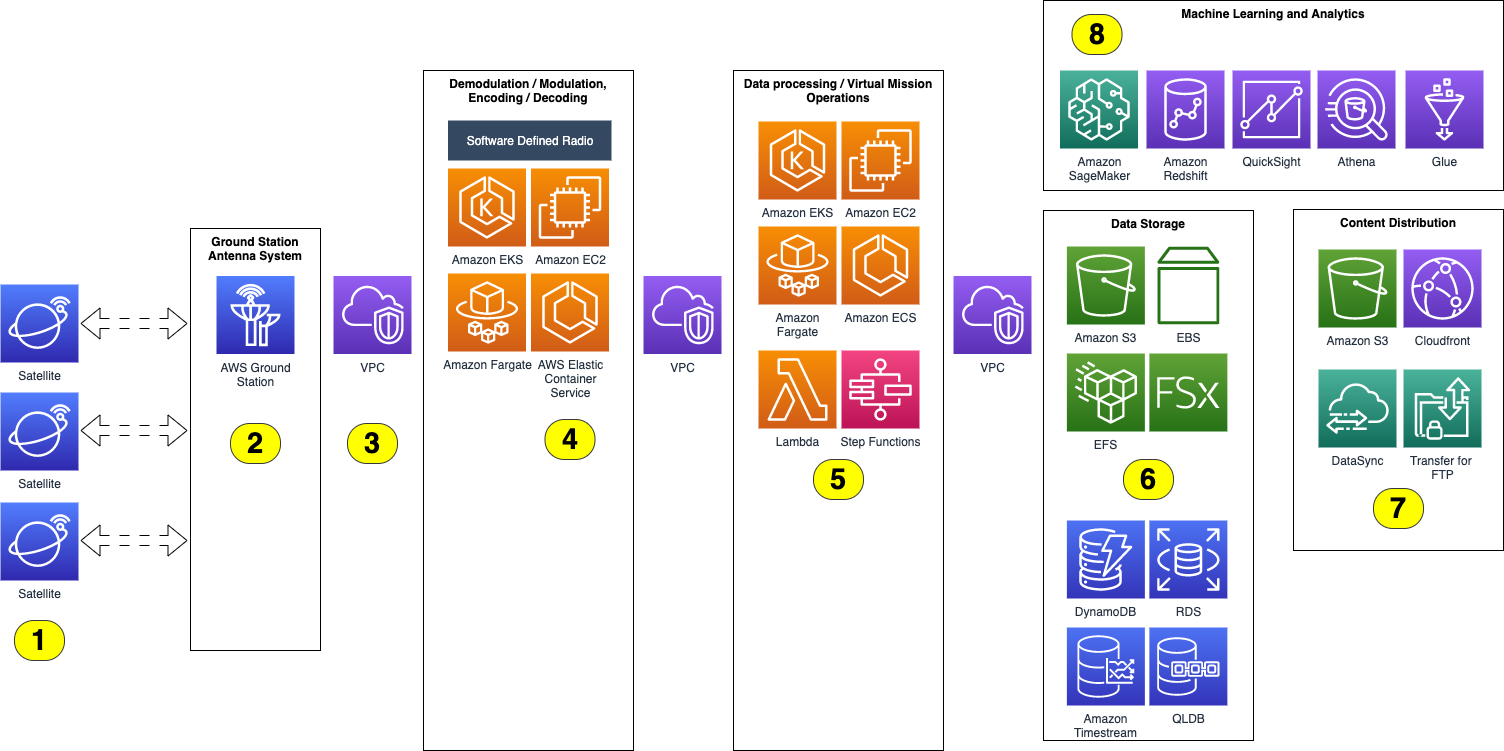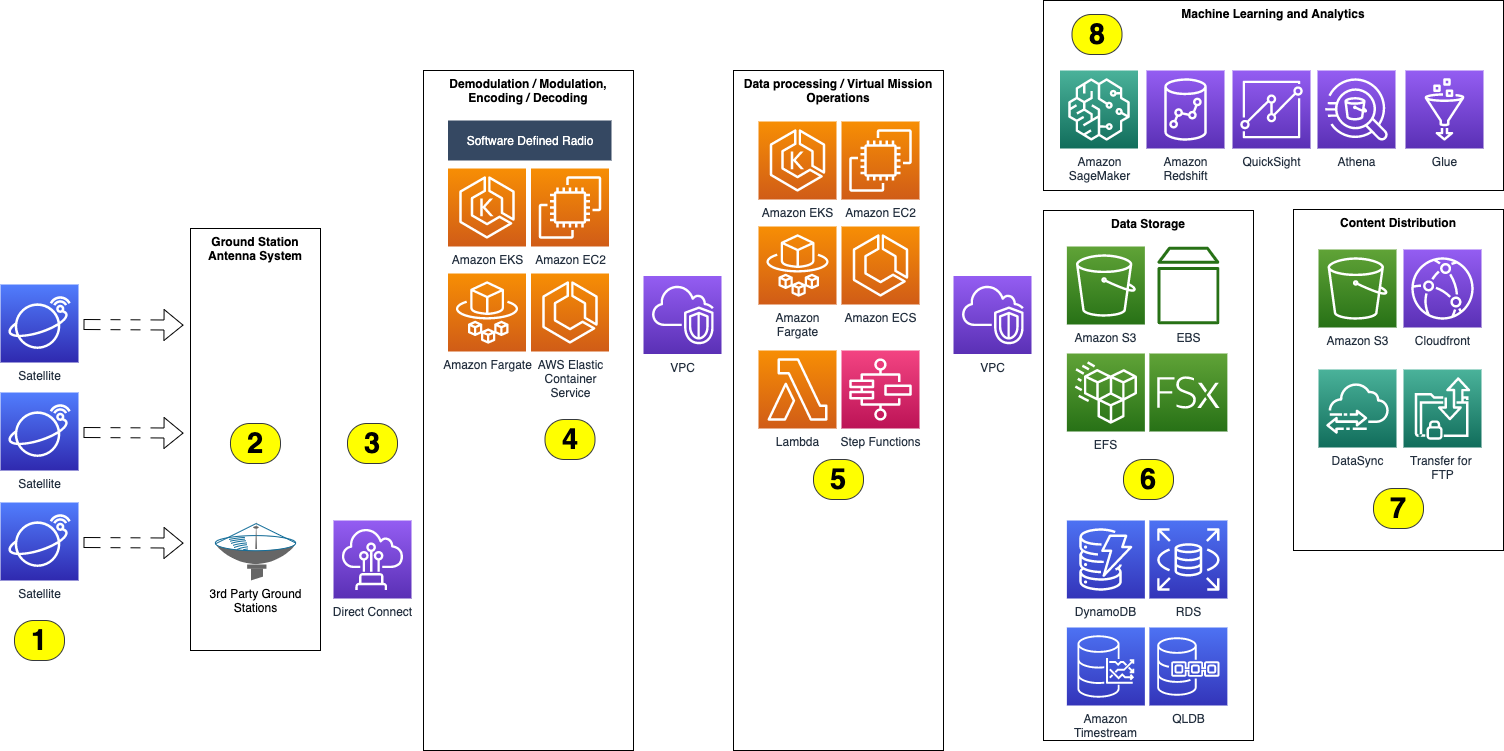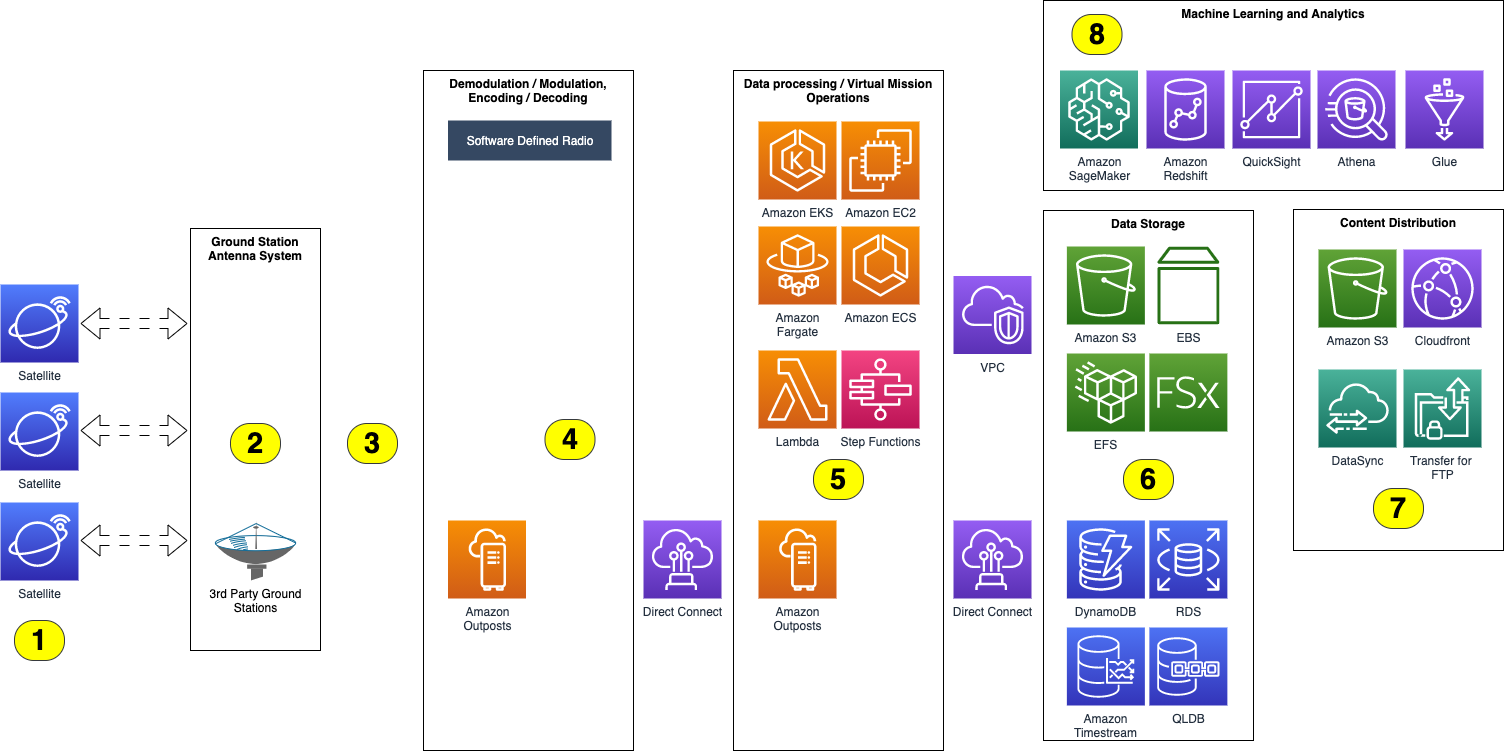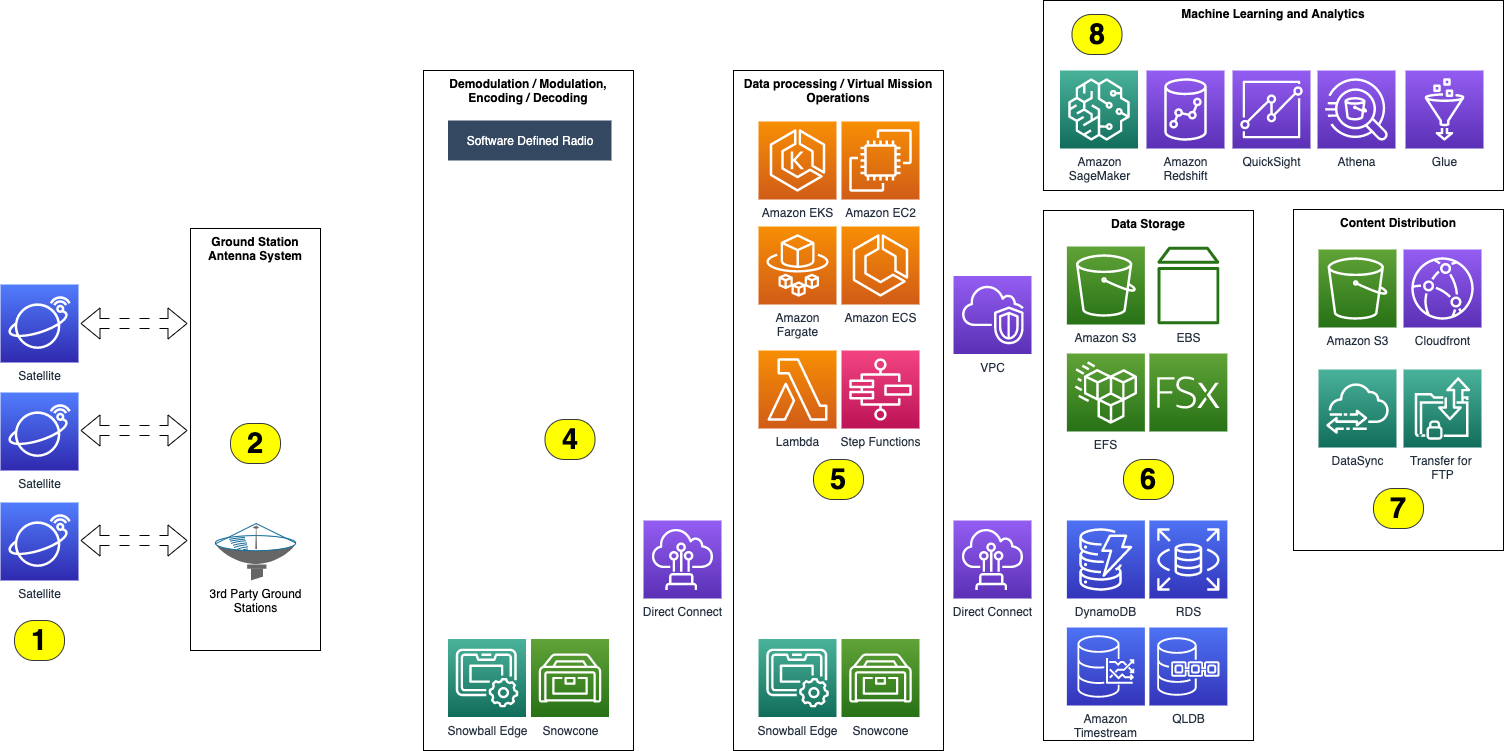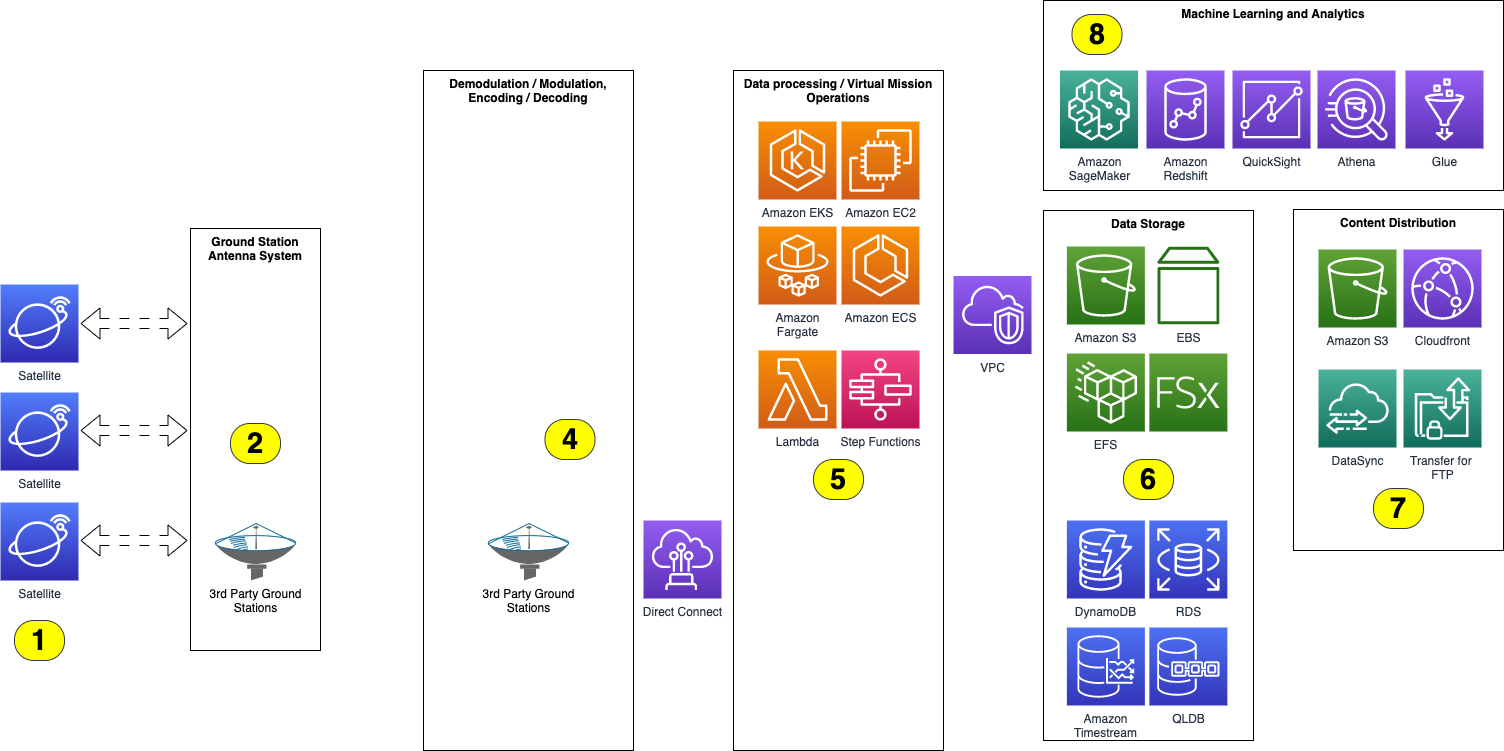AWS Public Sector Blog
Virtualizing the satellite ground segment with AWS
As the number of spacecraft and spacecraft missions accelerates, moving aerospace and satellite operations to the cloud via digital transformation — including the virtualization of the ground segment — is key for economic viability. Organizations can virtualize the ground segment by converting analog radio frequency waveforms to digital radio frequency streams (or vice-versa) as close as possible to the ground station antenna.
In this blog post, we explain the benefits of virtualizing the ground segment in the cloud and present core components of a reference architecture that uses Amazon Web Services (AWS) to support several stages of a comprehensive ground segment virtualization, including satellite communications, data processing, data storage, data distribution, and data analytics. Then, working from this model, we present additional reference architectures for virtualizing the ground segment that can accommodate various requirements and usage scenarios.
Benefits of virtualizing the satellite ground segment
Virtualization of ground segments can help scale, improve reliability, distribute and store data, avoid costly hardware refresh cycles, and innovate and adapt to change more quickly. With the cloud, you can deploy virtual servers that are tailored to your needs with a single API call or a few clicks of a mouse. In addition, the ability to manage your virtual server resources as code increases the possibilities to automate implementation and configuration steps, reducing the manual effort required to handle hundreds or thousands of satellite contacts.
Virtualization makes it simple to build reliable architectures, plus it increases the ability to recover from failure automatically. For example, you can launch several Amazon Elastic Compute Cloud (Amazon EC2) instances using a single API call to provision redundant signal processing paths in a virtualized ground segment with ease. In the cloud, replacing a virtualized function that exhibits anomalous behaviour can be as simple as terminating an underlying instance and replacing it with a new one. The cloud also improves reliability by integrating automated failover functions directly into control planes.
Once analog radio frequency (RF) data is digitized, i.e. converted from an analog radio frequency signal to a digital form, it can be simply distributed to other locations over long distances with no data loss or signal degradation, or stored for later processing. This provides additional flexibility when considering the geographical placement of teams and components.
Additionally, using cloud services places the hardware responsibility onto the cloud provider. It converts capital expenditure into operational expenditure so organizations can simplify budgets and financial planning to more closely align with usage patterns.
As the costs to put spacecraft into orbit decrease, traditional and NewSpace companies are working hard to reduce the timelines from mission design to launch. A software-based approach enables vendors of digital signal processing (DSP) solutions to build modular products and react more quickly to the needs of satellite operators, as building and distributing software is much simpler than doing the same with hardware.
Customers innovate in Earth observation with AWS for satellite operations
Leading satellite companies use AWS Ground Station to harness the benefits of ground segment virtualization. Capella Space is an Earth observation (EO) company that provides timely and reliable visibility with its Synthetic Aperture Radar (SAR) small satellite constellation. They are the first US company to launch and operate commercial SAR. “We have a constellation of very high-resolution, all-weather satellites and we are deploying more satellites in the near future to monitor our planet in as real time as possible,” said Daniel Getman, vice president of product at Capella Space. “As we scale our constellation, we will be accumulating more than 500 petabytes of data over the coming years. AWS Ground Station enables us to move our data from our satellite through AWS Ground Station antennas and into our secure virtual private cloud within milliseconds.”
Satellogic is a leader in high-resolution EO data collection. Satellogic’s mission is to democratize access to high-resolution satellite imagery, unlocking the power of geospatial data to solve the world’s most pressing challenges. “Each Satellogic spacecraft generates as much as 50 gigabytes of data daily. By 2023, we anticipate to be downloading and storing 124 terabytes of imagery daily,” said Matt Tirman, president of Satellogic NA. “Satellogic expects to scale quickly and effectively with just a click of the button as new AWS Ground Station locations come online. Being able to use any AWS Ground Station on demand, we can connect to our satellites in a dynamic way according to users’ needs for urgent tasking and imagery delivery. With AWS Ground Station network expansion, we can enable rapid responses in critical situations like natural disasters and emergency relief response efforts. AWS delivers the data exactly where we need it.”
Virtual ground segment reference architecture with AWS services
The reference architecture depicted in Figure 1 shows how AWS services can support multiple stages of ground segment virtualization in the cloud, which we detail in the following section.
 Figure 1. A reference architecture using AWS services that covers several stages of ground segment virtualization.
Figure 1. A reference architecture using AWS services that covers several stages of ground segment virtualization.
Stage 1: Satellites
Satellites orbiting the Earth communicate with ground stations using radio frequency (RF) communication links.
Stage 2: Ground station antenna system
Radio signals are received from the satellite (downlink) or transmitted to the satellite (uplink) by the ground station’s antenna system. When receiving data, the analog RF is amplified to compensate for path loss, digitized into a digital intermediate frequency (DigIF) stream, then passed on for demodulation and decoding. The key component which enables the translation between analogue and digital is the digitizer. When transmitting data, DigIF is received from the modulation and encoding stage (Stage 4), converted to an analog RF signal, amplified, and then transmitted to the satellite.
In Stage 2, satellite operators can choose to use AWS Ground Station or third-party antenna systems. AWS Ground Station offers the ability to digitize radio frequency signals as part of the managed service, while third-party ground stations may need to introduce digitizers capable of translating between the analog and digital radio frequency domains. Existing ground segment operators may choose to use their own ground stations, or use AWS Ground Station to augment their existing footprint.
Stage 3: Underlying network infrastructure
Data is transported between the ground station’s antenna system (Stage 2) and the (de)modulation and (de)encoding stage (Stage 4) differently depending on the ground stations used. If using AWS Ground Station, data travels along a resilient, high-bandwidth, low-latency, fully AWS-managed network directly into customers’ Virtual Private Clouds (VPCs). If using third-party ground stations, data can travel over an AWS Direct Connect network link provisioned to the nearest AWS regional point of presence for low latency.
Stage 4: Demodulation/modulation, decoding/encoding
During downlink operations, the DigIF stream received from Stage 2 is demodulated and decoded into raw satellite data streams (e.g. EO data) within Stage 4. During uplink operations, the opposite occurs: data streams (e.g. commands) are encoded and modulated into DigIF streams, then sent to Stage 2 for transmission to the satellite.
Satellite operators can use multiple types of compute services available in the cloud to process raw satellite data and derive useful information and intelligence. Amazon Elastic Compute Cloud (Amazon EC2) provides secure, resizable compute capacity in the cloud. Amazon Elastic Container Service (Amazon ECS), Amazon Elastic Kubernetes Service (Amazon EKS), and AWS Fargate help with the deployment, management, and scaling of containerized applications in the cloud.
AWS Outposts can locate software modems, like software defined radios (SDRs), closer to the antennas without the burden of managing the underlying compute and storage infrastructure. AWS Wavelength can deliver ultra-low latency applications to 5G devices. Occasionally-connected and tactical environments can leverage portable devices within the AWS Snow Family, like AWS Snowball edge appliances and AWS Snowcone.
SDRs are a core component of the architectures that virtualize the ground segment. SDRs package complex digital signal processing (DSP) algorithms, previously available only in specialized hardware, into software that can be hosted in the AWS Cloud. Many AWS Cloud services and features can host SDRs, as well as a growing number of AWS Partners that develop these solutions. Commercial SDR solutions are available on the AWS Marketplace which have been tested in AWS and integrated into virtualized ground segment architectures by our customers.
Stage 5: Data processing and Virtual Mission Operations
Several AWS cloud services support downstream processing depending on the nature of the downlink. Some data streams contain satellite imagery that needs to be rectified and enriched to generate higher-level imagery products. Other data streams transport telemetry data whose processing involves decapsulating and parsing metrics. In either case, we refer to the result as business data.
In the uplink direction, during command and control (C&C) operations, this stage sequences and encapsulates satellite payload commands for transmission, then sends them to Stage 4 for encoding and modulation
You can use the compute services mentioned in Stage 4 in this stage. Additionally, you can use AWS Lambda to build powerful event-driven applications. AWS Lambda is a serverless compute service that lets you run code without provisioning or managing servers, so you can create workload-aware cluster scaling logic, maintain event integrations, or manage runtimes. Multiple Lambda functions can also be chained together into intelligent logic-driven applications using AWS Step Functions.
Stage 6: Data storage
Business data, such as high-level imagery products, telemetry, or C&C data, needs to be stored and made available for asynchronous retrieval by consumers. Consumers can be internal, like satellite operations or data processing teams, or external. Raw satellite data may need to be archived in some cases, too. This storage can quickly scale to multiple petabytes.
Amazon Simple Storage Service (Amazon S3) is a secure file and object storage service that allows customers to scale storage resources up and down to meet fluctuating demands. Customers can store raw satellite and business data as it increases at a pace of dozens of gigabytes, or terabytes, per day.
You can directly attach Amazon Elastic Block Store (Amazon EBS) volumes to Amazon EC2 instances to provide high-performance block storage. Additionally, you can use Amazon Elastic File System (Amazon EFS) and Amazon FSx to provide elastic network file systems and highly performant feature-rich file systems respectively.
For database needs, AWS provides over 15 purpose-built database engines including relational, key-value, document, in-memory, graph, time series, wide column, and ledger databases. These include Amazon Relational Database Service (Amazon RDS) for relational databases; Amazon DynamoDB for single-digit millisecond key/value access; Amazon Timestream for time series data; and Amazon Quantum Ledger Database (Amazon QLDB) for maintaining an immutable, cryptographically verifiable log of data changes.
To protect your data in the cloud, the storage and database services mentioned in this stage can also provide fully integrated encryption using AWS Key Management Service (AWS KMS).
Stage 7: Content distribution
Once stored, data can be distributed to consumers: internal operators and customers requesting it through a graphical frontend, or applications retrieving it using programmatic API calls to complete tasks like training a machine learning (ML) model.
Amazon S3 provides simple access to data using a HTTPS endpoint over public or private networks. You can use it in conjunction with Amazon CloudFront, a content delivery network (CDN) service that securely delivers data, videos, applications, and APIs to customers globally with low latency and high transfer speeds, all within a developer-friendly environment. Data can also be synchronized with off-cloud locations using AWS DataSync or accessed via applications that require file transfer protocol (FTP) using AWS Transfer for FTP and FTPS. Finally, AWS Data Exchange makes it simple to find, subscribe to, publish, and use third-party data in the cloud, which can be leveraged by satellite data providers to bring products to wider audiences.
Stage 8: Machine learning and analytics
Finally, satellite operators can derive additional value from business data stored in AWS by leveraging analytics services in the cloud. Amazon Sagemaker helps data scientists and developers to prepare, build, train, and deploy high-quality ML models quickly by bringing together a broad set of capabilities purpose-built for ML. Amazon Redshift helps analyze data across operational databases, data lakes, data warehouses, and third-party data sets. Amazon Athena is a serverless service that makes it simple to analyze data in Amazon S3 using standard SQL queries. Amazon Quicksight provides ML-powered data visualization. With AWS Glue, you can discover, prepare, and combine data for analytics, machine learning, and application development.
Reference architecture for common virtual ground segment usage scenarios
These specific reference architectures use the services and technologies we discussed previously, and can accommodate common scenarios.
Scenario A: Satellite operator using AWS Ground Station for X-band downlink

Figure 2. Scenario A reference architecture.
AWS Ground Station acquires, demodulates, and decodes downlink signals from your satellite. The data is delivered in seconds to an Amazon S3 bucket using the Amazon S3 data delivery feature of AWS Ground Station. If you prefer to architect for the lowest possible delivery latency, you can process the data received using Amazon EC2 before uploading the result to Amazon S3. Once in Amazon S3, you can use the services mentioned in Stages 5, 6, 7 and 8 to further process, analyze, and distribute the data.
Scenario B: Satellite operator using AWS Ground Station for S-Band C&C operations
Figure 3. Scenario B reference architecture.
AWS Ground Station acquires and digitizes the downlink signal, then delivers the digitized stream to an Amazon EC2 instance in milliseconds. The Amazon EC2 instances host an SDR. The SDR demodulates and decodes the data; then the data is stored in Amazon S3 or streamed to a mission control backend hosted in the cloud or on-premises.
For uplink, tele-commands are prepared in the mission control backend and streamed to the SDR in real-time during the contact. The SDR encodes and modulates the data, then streams to AWS Ground Station for transmission to the satellite.
Scenario C: Third-party ground station antenna using AWS Cloud services for virtual mission operations
Figure 4. Scenario C reference architecture.
This scenario is identical to Scenario B, except that a third-party ground station handles the downlink and uplink signals. AWS Direct Connect provides a secure low-latency connection between the third-party ground station and the cloud. Downlink and uplink operations operate identically to Scenario B — modulation/demodulation and encoding/decoding operations take place in SDRs in the cloud.
The performance of the network link between the ground station and the cloud, in terms of throughput, latency and jitter, must be enough to accommodate the requirements of each specific use case. The network throughput required to transport a digitized RF signal might be a blocker to transport signals of several hundreds of megahertz, but it may be reasonable for signals of several hundreds of kilohertz. If the network performance is not suitable, consider the solutions described in Scenarios E, F, and G, to follow, which place compute services (and therefore the SDRs) closer to the ground station.
Scenario D: Third-party ground station antenna using AWS Cloud services for high-rate data downlink
Figure 5. Scenario D reference architecture.
In this scenario, third-party ground station antennas receive and digitize the data sent into the cloud for demodulation, decoding, and further data processing.
Like Scenario C, there are network latency and bandwidth considerations. However, unlike Scenario C, payload high-rate data downlink operations rarely need to be conducted in real-time. In this scenario, the data received in the cloud can be processed in near-real-time (slightly lagging the real-time downlink) or processed offline. Offline processing requires two stages: 1) Digitized RF data is sent to the cloud and stored in an Amazon S3 bucket; and 2) an Amazon EC2 instance pulls the data from the Amazon S3 bucket and performs demodulation and decoding operations. You can then store and process the decoded data further in the cloud as required.
Scenario E: Third-party ground station antenna using AWS Outpost services for C&C or high-rate data downlink
Figure 6. Scenario E reference architecture.
This scenario is a combination of Scenarios C and D, except compute services performing (de)modulation and (de)coding functions run on an AWS Outpost as close to the ground station antenna as possible. Downlinked data is sent into the cloud from the AWS Outpost over a secure Direct Connect network link for further processing. A Direct Connect link between the SDR running on an AWS Outpost and the servers running the mission operations software facilitate C&C operations. Alternatively, you could run the mission operations software on AWS Outposts.
Scenario F: Mobile/Intermittently-connected third-party ground station antenna using the AWS Snow Family for virtual mission operations or high-rate data downlink
Figure 7. Scenario F reference architecture.
In some cases, the ground station antenna may be mobile. You can use devices from the AWS Snow Family to host SDRs and other mission operations functions close to the antenna in environments with intermittent or no connectivity to the cloud. Satellite data can then be transferred into the cloud for further processing when the devices regain stable network connectivity.
Scenario G: Third-party ground station antenna and DSP using the cloud for pre- and post- contact operations
Figure 8. Scenario G reference architecture.
In this scenario, the third-party ground station conducts all downlink and uplink analog and digital RF operations. Post-contact, the downlinked data is transferred into the cloud using Direct Connect, then further processed and distributed as required. Pre-contact, data can also be prepared in the cloud for transmission to the satellite, then transferred to the third-party ground station before the satellite contact.
Summary for virtualizing the ground segment with AWS
In this article, we presented reference architectures showing how AWS services can work together to create a comprehensive virtualization of the ground segment in the cloud, including in various dynamic scenarios.
Do you have any questions related to this blog post, or how AWS can help you digitally transform your satellite operations? Contact us directly via email or through the AWS Professional Services page.
Read more about AWS for aerospace and satellite:
- Amazon and AWS to reimagine space station operations and logistics for Orbital Reef
- How Natural Resources Canada migrated petabytes of geospatial data to the cloud
- Canada’s Federal Geospatial Platform supports decision-making using AWS
- Analyze terabyte-scale geospatial datasets with Dask and Jupyter on AWS
- Automated Earth observation using AWS Ground Station Amazon S3 data delivery
- Earth observation using AWS Ground Station: A how to guide
Subscribe to the AWS Public Sector Blog newsletter to get the latest in AWS tools, solutions, and innovations from the public sector delivered to your inbox, or contact us.
Please take a few minutes to share insights regarding your experience with the AWS Public Sector Blog in this survey, and we’ll use feedback from the survey to create more content aligned with the preferences of our readers.

